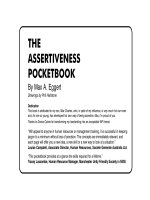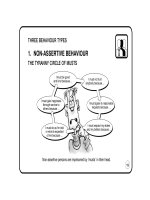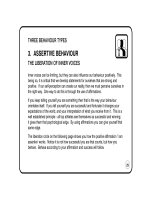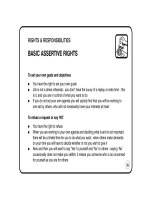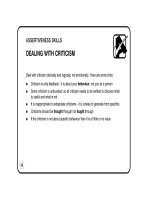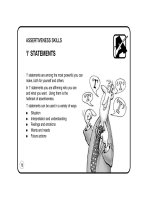THE CHALLENGERS POCKET BOOK phần 7 doc
Bạn đang xem bản rút gọn của tài liệu. Xem và tải ngay bản đầy đủ của tài liệu tại đây (97.48 KB, 10 trang )
CHALLENGERS
THE TROUBLE-MAKER
Reframe (Consequences) Demonstrate the consequences of the outburst. Say
something like: 'You obviously have very strong feelings about this. This must also mean
that you think/feel ' Reframe consequences of the negative/aggressive attitude until
trouble-maker retreats.
Reframe (Table-turn) Use trouble-maker's own arguments against him/her. Example:
TROUBLE-MAKER: 'This is ridiculous! We simply don't have time to do all this.'
YOU: 'I understand. But don't forget it's not compulsory. It's optional to be a professional
in your job.'
Psychological Judo Ask for a big favour to channel negative energy into something
positive. For example, you could ask them to work the camera or lead a small group
feedback session during a video role play exercise. Appoint them as 'devil’s advocate' to
intervene whenever they feel you're leading the group astray. Applaud their courage in
standing up for their opinions and constantly ask them for negative comments so as to
get both sides of the argument out in the open.
(When the spotlight gets too hot even trouble-makers melt!)
61
CHALLENGERS
THE WHISPERER
Profile
● Makes whispered comments to neighbour.
NB There is only one whisperer - the other
is the whisperee! In many cases the
whisperee is an unwilling accomplice so you
only have one person to handle.
Refocus
Use an overhead transparency or the flip
chart to attract and refocus their attention.
DO NOT SAY: 'Would you like to share
your interesting conversation with
everyone?' It's sarcastic and directive
and likely to cause resentment.
62
CHALLENGERS
THE WHISPERER
Non-verbal
To use this technique effectively you must always assume that the whisperers are
enthusiastically building on something you said – even if they're not!
1. Stop talking and look unthreateningly at them
2. Wait for them to look at you
3. Non-verbally ask for their permission to continue (eyebrows raised, head-nod and
perhaps a silent-mouthed 'OK?')
The sincerity and vulnerability projected by your positive mind-set is normally guaranteed
to provoke a spontaneous sharing of the whispered message. It will also encourage
whisperers to self-control in future.
Psychological Judo
Wait until after a break. Explain that you have a lot of ground to cover in the forthcoming
session. Invite anyone who has any difficulty in keeping up (getting old or having trouble
understanding) to ask their neighbour. Say, with a smile, that you don't mind them
whispering to each other as long as they are discreet!
63
CHALLENGERS
THE WOOLLY THINKER
Profile
● Makes vague, abstract contributions.
● Asks rambling unclear questions.
Self-revelation
When asked an unclear question, say something like:
'I'm sorry but I'm not sure I understood your point there.
You feel that ?'
Blockbusting
Ask for clarification of contributions with 'which, what,
when and who specifically?' questions.
64
CHALLENGERS
THE WOOLLY THINKER
Reflect/Deflect
After vague questions or contributions make a purposefully more specific interpretation
of what you think they meant. For example:
1. WOOLLY THINKER: 'Well, it's all a question of motivation really.'
YOU: 'So what you're saying is that you find it demotivating working in that
department?'
WT: 'No, no. Not me! No, I just think the office staff need to feel more
motivated about doing the routine work.'
YOU: 'Does anyone else have examples of demotivated office staff?'
2. WT: 'I think it's a communication problem.'
YOU: 'Your boss doesn't talk to you?'
WT: 'Oh yes, don't get me wrong. No, there's just too much crap on the electronic
mail every morning.'
YOU: 'Fred, you're the electronic mail specialist, how do you see this problem?'
65
CHALLENGERS
THE YAWNER/SLEEPER
Profile
Phase 1:
● Yawns.
● Stifles yawns.
● Eyelids droop.
Phase 2:
● Closes eyes and seems to be (is) sleeping!
Naming
Use their name in examples and metaphors without looking at them. For example: 'Let's
imagine that Miss Y was one of our customers ' Get
a discussion going with the rest of the group.
Once she's had a chance to 'wake up', catch
her eye and say something like: 'In a moment
I'll ask Miss Y, our customer, how she would
feel about what we're saying.'
66
CHALLENGERS
THE YAWNER/SLEEPER
Non-verbal
In one of her 'open-eyelid' moments catch her eye and nod/wink or give some other signal
to indicate that you know she's dropping off but won't show her up in front of the others.
Confrontation (use with care!)
Address the problem openly. Say something like: 'Mr X obviously had a hard night last
night and is having a tough time keeping awake. How can we help him?' If you do it in a
good humoured way, the adrenalin rush caused by the embarrassment will usually help
them over the 'low'. (Think of when it's happened to you!)
Call a Break
Allow the sleeper and the others to get some fresh air.
Psychological Judo
(To use when showing videos in the afternoon, for example)
Say something like: 'Now is the ideal time for anyone over 35 who needs a rest after lunch,
to have a quick shut-eye. The rest of us are going to watch this excellent film!' You’ll notice
how the older ones go out of their way to show how much they enjoyed the video!
67
NOTES
68
TECHNIQUES AND TACTICS
69
TECHNIQUES AND TACTICS
IT’S THEIR COURSE
On the following pages are full descriptions of each of the intervention techniques/tactics
mentioned in the Challengers section.
Please remember that there are no 'difficult' participants!
● It's their course or meeting.
● Challengers are much less disruptive when the trainer/leader is non-defensive and
serene.
● Intervention techniques are necessary only to:
- optimise resources and get to learning/consensus faster and with less energy;
- allay the trainer's fears of losing control of the group.
70

